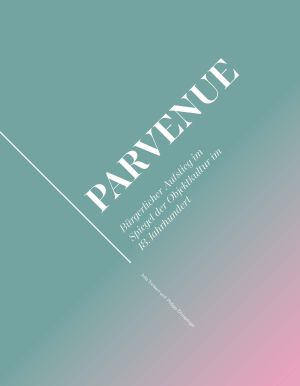
How to Cite
Trinkert, Julia and Zitzlsperger, Philipp (Eds.): Parvenue: Bürgerlicher Aufstieg im Spiegel der Objektkultur im 18. Jahrhundert, Heidelberg: arthistoricum.net, 2023. https://doi.org/10.11588/arthistoricum.1204
Published
06/06/2023
The printed publication was published in 2023 by Sandstein Verlag Dresden. ISBN: 978-3-95498-733-7
Parvenue
Bürgerlicher Aufstieg im Spiegel der Objektkultur im 18. Jahrhundert
Parvenus of the 18th century are social actors with a special orientation, as they were more dependent than others on the use of material culture for rapid career advancement in the competitive societies of the early modern period. For representation through the arts and crafts, their central challenge was to prudently moderate the use of artefacts for this purpose between conformity and distinction. As instruments of vertical social mobility that have received little attention so far, (art) objects and their identity-creating attributions of meaning therefore play a prominent role: they are the foundation of a social-historically flanked history of art and images.
Chapters
Table of Contents
Pages
PDF
Theorie
Skizzierungen zu einem Deutungsschema
16-26
Visualisierungen des sozialen Aufsteigers und Bildstrategien zu seiner Abwehr
48-61
Forschungsergebnisse
Zitrusfrüchte als Luxusartikel im 18. Jahrhundert
88-91
Die monochromen Wachsbildnisse von Johann Christoph Haselmeyer in Krefeld
97-104
Ein ›standesgemäßer Kosmos‹ im Herrenzimmer des Roten Hauses in Monschau
105-121
Die bestickte seidene Weste des Carl Philipp von Buttlar
122-124
Erfolgsaussichten von Aufstiegsstrategien im dänischen Adel und im hanseatischen Bürgertum am Beispiel von Heinrich Carl von Schimmelmann
145-176
Ästhetisches Kapital als Indikator kultureller Bildung und universellen Machtanspruchs
177-193
Zur Deutung von chinesischen Porzellanen und chionoisen Fayencen auf Gemälden
195-213
Heinrich Carl von Schimmelmann und sein Diener Heinrich Carl Ambach (1769 von St. Croix), 1775 (?)
214-217
Textile Imitationen als ästhetisches, modisches und ökonomisches Prinzip in der Seidenweberei des 18. Jahrhunderts
222-239
Anzeigen des ›Duisburger Intelligenz-Zettels‹ als Quelle für die Kleidungsforschung
240-257
Das Projekt ›PARVENUE – Bürgerlicher Aufstieg im Spiegel der Objektkultur im 18. Jahrhundert‹ und seine Teilprojekte
266







